 |

18 - 25 June 2005
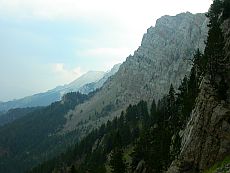 Serra del Cadí
© Teresa Farino
Eight BSBI members flew to Barcelona to join Teresa Farino,
who has been leading wildlife tours in the Catalan Pyrenees since 1999. During the week we recorded almost 600 species
of vascular plant, including several Pyrenean endemics and many which are common in Spain but becoming increasingly scarce
in Britain.
Serra del Cadí
© Teresa Farino
Eight BSBI members flew to Barcelona to join Teresa Farino,
who has been leading wildlife tours in the Catalan Pyrenees since 1999. During the week we recorded almost 600 species
of vascular plant, including several Pyrenean endemics and many which are common in Spain but becoming increasingly scarce
in Britain.
18 June - around Prullans
After disembarking from our respective aircraft into the searing heat of the Barcelona mid-afternoon, our leader whisked us rapidly north-westwards to the cooler climes of the mountains. En route we passed the conglomerate massif of Montserrat, its jagged silhouette resembling some great prehistoric monster stranded in the arid plains, arriving about two hours later at our base in Prullans de Cerdanya. The Cerdanya is a broad, high-altitude plain formed by the river Segre, lying southeast of the Principality of Andorra; it is hemmed in by the limestone Serra del Cadí to the south and the siliceous mountains rising to the French border to the north. Much of the area to the south of the river lies within the Cadí-Moixeró natural park.
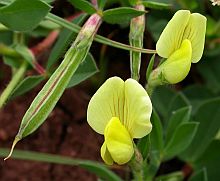 Dragon's-teeth
Dragon's-teeth
Tetragonolobus maritimus
© Teresa Farino
After 'high tea' in the hotel garden, we took a leisurely stroll in the foothills behind the village. A Cuckoo called in the distance and a Western Whip Snake basked in the last of the afternoon sunshine. The Bristol contingent soon recognised Allium sphaerocephalon (Round-headed Leek) and Scirpoides holoschoenus (Round-headed Club-rush), with the bright yellow flowers of Tetragonolobus maritimus (Dragon's-teeth) completing a trio of West Country rarities. However, the drooping heads of the grass Melica ciliata ssp. ciliata (Hairy Melick), the three-lobed leaves of Hepatica nobilis (Hepatica) and Galium maritimum, an unusually brown-flowered bedstraw, soon told us that we were definitely no longer in Britain.
Salvia pratensis (Meadow Clary), as during the whole of the week, was absolutely everywhere, though curiously
unlike in our own country all the plants appeared to be hermaphrodite, with no male-only plants observed. Butterflies
were abundant, with the Adonis Blue being particularly striking, while the crystal clear song of the Nightingale cut through the increasing stillness of the now approaching dusk. On the way back to Prullans, we identified Tordylium maximum (Hartwort) by the roadside.
19 June - Orden & Talltendre
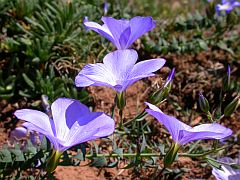 Beautiful Flax
Beautiful Flax
Linum narbonense
© Teresa Farino
We could hardly complain to the hotel management, but we were woken at daybreak by the rich luscious notes of a Golden Oriole. After breakfast we took a short drive in the direction of the village of Orden. A Hoopoe swooped across the road as a couple of dozen Black Kites circled above trying to gain the thermals. Below the village, the dry and dusty south-facing hillside was dominated by a scrub of Buxus sempervirens (Box) and Juniperus communis ssp. communis (Common Juniper), with a rich calcareous community clinging tenaciously to the shallow rocky soils. Botanical highlights here included Linum narbonense (Beautiful Flax), Eryngium campestre (Field Eryngo), the bronze-flowered goat's-beard Tragopogon crocifolius and Dipcadi serotinum (Dipcadi), looking every bit like a 'brown bluebell'. The entomologically minded marvelled at a Spanish Swallowtail and the sheer abundance of Black-veined White butterflies, now extinct in Britain.
 Alpine Aster
Alpine Aster
Aster alpinus
© Teresa Farino
A second roadside halt by a dung heap and a couple of small puddles proved to be the lepidopterist's nirvana, hosting Wood White, Glanville, Spotted and Knapweed Fritillaries, White Admiral and hoards of Silver-studded Blues. However, it was the botany that we had come for, and having admired such eye-catching species as Campanula persicifolia (Peach-leaved Bellflower) and Digitalis lutea (Straw Foxglove), we set off to explore the adjacent scrub, where a rich xerophytic flora included Carex humilis (Dwarf Sedge), Trinia glauca (Honewort), Aster alpinus (Alpine Aster) and Cotoneaster integerrimus (Wild Cotoneaster), although the pale-lemon flowers of the pheasant's-eye Adonis aestivalis attracted the most attention.
Orden lies at an altitude of 1,490m, and we climbed gently from here to the next village, Talltendre. As we passed onto
more acidic rock, the flora began to change, with Silene nutans (Nottingham Catchfly) giving way to Potentilla argentea (Hoary Cinquefoil), Asplenium septentrionale (Forked Spleenwort) and Plantago maritima ssp. serpentina (Fleshy Plantain). Dark Green Fritillary butterflies fluttered past the glaucous fruiting stems of Arabis glabra (Tower Mustard) along a trackside blue with the hue of Centaurea cyanus (Cornflower). Beyond Talltendre, we came upon haymeadows with an altogether more luxuriant vegetation: heads of Trollius europaea (Globeflower) peppered fields now dominated by Persicaria bistorta (Common Bistort), interspersed with Anthericum liliago (St Bernard's Lily), and Gentiana lutea (Great Yellow Gentian). As we retraced our steps, we paused briefly to view a Woodchat Shrike which had assumed a sentinel position atop a dead tree.
20 June - Clot de l'Orri
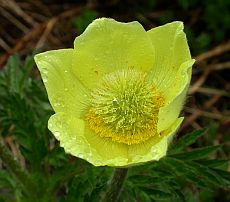 Alpine Pasque Flower
Alpine Pasque Flower
Pulsatilla alpina ssp. apiifolia
© Teresa Farino
The second day, spent high in the siliceous foothills of the Pyrenean massif, was a complete contrast in scenery and flora.
A short roadside stop for Dianthus armeria (Deptford Pink) and Listera ovata (Twayblade) was followed by a longer
streamside halt near a Nordic ski station. Here the meadows were bursting with colour: Gentiana acaulis (Trumpet
Gentian), G. pyrenaica (Pyrenean Gentian), Veratrum album (White False Helleborine) and Lilium pyrenaicum
(Pyrenean Lily), together with Phyteuma spicatum (Spiked Rampion) and - a big surprise to British eyes - a field full
of Scorzonera humilis (Viper's-grass). Here too we saw our first Rhododendron ferrugineum (Alpenrose),
whose rose-pink flowers became a constant companion during our hike up through the forest of Pinus uncinata
(Mountain Pine) and P. sylvestris (Scots Pine), sadly ravaged by acid rain.
As we climbed towards the Clot de l'Orri, we noticed Gymnocarpium dryopteris (Oak Fern), while the yellow-flowered
Pulsatilla alpina ssp. apiifolia (Alpine Pasque Flower) vied with abundant Lychnis alpina (Alpine Catchfly)
- more plants in a hundred metres than the entire British population! - and the delightful yellow-flowered stonecrop
Sedum alpestre for eye-catching beauty. Less colourful, but no less novel, was the stately umbellifer
Molopospermum peloponnesiacum ssp. peloponnesiacum ("repeat after me.", said our leader). The path ended in
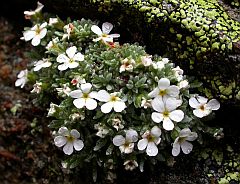 Androsace vandellii
© Teresa Farino
a magnificent corrie containing a peatbog, where the flora included Polygala alpestris (Mountain Milkwort),
Veronica alpina (Alpine Speedwell), V. bellidioides (Violet Speedwell, not previously recorded in the area),
Pinguicula grandiflora (large-flowered butterwort), Loiseleuria procumbens (Trailing Azalea), and that other
British rarity - if indeed it is native here - Homogyne alpina (Alpine Colt's-foot).
Androsace vandellii
© Teresa Farino
a magnificent corrie containing a peatbog, where the flora included Polygala alpestris (Mountain Milkwort),
Veronica alpina (Alpine Speedwell), V. bellidioides (Violet Speedwell, not previously recorded in the area),
Pinguicula grandiflora (large-flowered butterwort), Loiseleuria procumbens (Trailing Azalea), and that other
British rarity - if indeed it is native here - Homogyne alpina (Alpine Colt's-foot).
Those who climbed the final kilometre or so towards Andorra were rewarded with sightings of Alpine Marmot, as well as Primula integrifolia (Entire-leaved Primrose), Juncus trifidus (Three-leaved Rush), Bartsia alpina (Alpine Bartsia), the rock-jasmine Androsace vandellii and the rare saxifrage Saxifraga aspera, endemic to the Pyrenees. Then the heavens opened and the descent back to the road completed the resemblance to the Scottish hills ("I'm sure there was a cairn here…"), but nevertheless, we all agreed that it had been a splendid day.
21st June - Coll de Pal
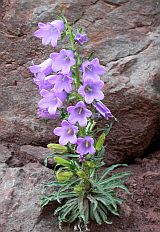 Pyrenean Bellflower
Pyrenean Bellflower
Campanula speciosa
© Teresa Farino
The route today led back down the Barcelona road and through the impressive 5-km Túnel del Cadí, taking us to the southern flank of the Cadí-Moixeró park, and the information centre in Bagà, where many of us purchased a local atlas flora in Catalan.
The day's botany began along a shady track off the mountain road leading to the Coll de Pal, where we saw
Lilium martagon (Martagon Lily) tantalizingly in bud near a fruiting Arabis turrita (Tower Rock-cress) with its conspicuously hung, flattened pods, with Rumex scutatus (French Sorrel), abundant on a steep shaly scree, and our first Saxifraga paniculata (Livelong Saxifrage). Meanwhile, after rummaging in the undergrowth, our resident amphibian expert produced a fine gleaming Fire Salamander, like a rabbit out of a hat. Back at the minibus, we watched a host of butterflies enjoying the sunny bank, including Apollo and the gorgeous Moroccan Orange-Tip. Higher up we encountered several spikes of Campanula speciosa (Pyrenean Bellflower) in full multi-flower on the roadside cliff, with the verges by the viewpoint a little further on populated by Teucrium polium ssp. aureum (Felty Germander) and Santolina chamaecyparissus (Lavender-cotton).
The highlight of the day was a small ravine hiding the entrance to a disused mine, reached by a grassland track that itself
presented treasure on treasure. Spiny Astragalus sempervirens (Mountain Tragacanth) was followed by grandly
 Reddish Saxifrage
Reddish Saxifrage
Saxifraga media
© Teresa Farino
three-dimensional Saxifraga longifolia (Pyrenean saxifrage), Pedicularis comosa (Crested Lousewort),
Scutellaria alpina (Alpine Skullcap), Onosma bubanii (Pyrenean Golden Drop) and mats of haze-blue
Globularia cordifolia (Matted Globularia) and G. repens. Sometimes the plant shapes and structures
were the more entrancing, sometimes their colours. In the latter camp, the champion was surely the ultra-maroon
Nigritella nigra (Vanilla Orchid).
The ravine itself was like an inner sanctum to which we had a free pass: no wonder it was a favourite site of Teresa's. Here were Anemone narcissiflora (Narcissus-flowered Anemone) and tufts of pale-mauve Valeriana apula, high on the face, while at eye-level we encountered Saxifraga media (Reddish Saxifrage) and the white-flowered Pulsatilla alpina ssp. font-queri, with the gaps between the boulders studded with Viola biflora (Yellow Wood-violet). Cries of Alpine Choughs echoed above, and at last, appetites whetted by bud after bud, we found Ramonda myconi (Ramonda), bright-eyed in flower.
Then the rain began. We sought shelter for lunch at a deserted ski centre, beneath spectacular clouds and surround-sound thunder. One last drenched sally rewarded us with Gentianella campestris (Field Gentian) and the rock-jasmine Androsace villosa before we had to admit defeat. Calling into Bagà in search of coffee, we found the town in Marie Celeste mode, streets empty, shops and cafés shut - all but one excellent bar in the square where the locals were just finishing their siesta, under the disgruntled gaze of a stuffed boar's head.
22 June - Sanavastre & La Molina
A 7am start to visit the gravel pits of Sanavastre, past cornflower-charged arable fields, where we found, emerging from the early morning mist, a sandy bank populated by European Bee-eaters, with Rock Sparrows taking vacant possession of disused nest sites. A Skylark was singing overhead and a Wheatear crossed the lake below, seemingly undisturbed by the thunder of heavy lorries and the jetsam of discarded refrigerators.
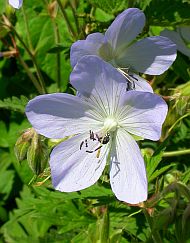 Meadow Crane's-bill
Meadow Crane's-bill
Geranium pratense
© Teresa Farino
After breakfast, we returned to water-meadows in the same locality, fed by the fast running Segre river and fringed with Iris pseudacorus (Yellow Flag) and Geranium pratense (Meadow Crane's-bill). Familiar plants seen along the river bank included Isatis tinctoria (Woad), Chelidonium majus (Greater Celandine), Saponaria officinalis (Soapwort), Malva moschata (Musk Mallow) and Anchusa arvensis (Bugloss). We also encountered Scrophularia crithmifolia (a subspecies of S. canina, endemic to Spain), and the delicate Micropyrum tenellum (Gravel Fescue), which extends no further north than France.
Among the abundant butterflies were Clouded Yellow, Marbled Fritillary, Large Tortoiseshell, Iberian Marbled White,
Pearly Heath and Mallow Skipper, while flashes of red signalled the Scarlet Tiger moth in flight. Beautiful Demoiselles,
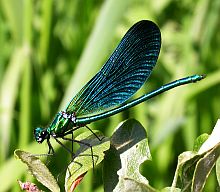 Beautiful Demoiselle
Beautiful Demoiselle
Calopteryx virgo meridionalis
© Teresa Farino
Large Red Damsels and Southern Skimmers were the principal dragonflies in evidence, and we also encountered several
Great Green Bush-crickets and Violet Carpenter Bees of the genus Xylocopa.
For lunch we chose a stream-side location high above the village of Alp, close to the ski resort of La Molina, surrounded by Lilium martagon in bud, Potentilla rupestris (Rock Cinquefoil) in flower and Helleborus viridis (Green Hellebore) in fruit. Moving upstream past huge Wood Ant nests, we located Geum rivale (Water Avens) and Asplenium seelosii ssp. glabrum, the latter confined to the limestone rocks of the eastern Pyrenees, as well as Valeriana tripteris (Three-leaved Valerian) and Luzula nivea (Snowy Wood-rush).
The last stop of the day was to a sun dried bank near Alp to look for Gentiana cruciata (Cross Gentian), although sadly the plants were not in flower. Indeed, even the buds appeared to be absent, but compensation was found in the photo opportunity presented by a mating pair of Mazarine Blue butterflies.
23 June - Prat del Cadí
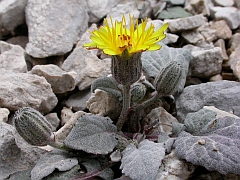 Pygmy Hawk's-beard
Pygmy Hawk's-beard
Crepis pygmaea
© Teresa Farino
For our big trek of the week, we set off from the village of Estana, at the foot of the Cadí ridge, where a bar was carefully noted for the return trip. After admiring a Colorado Beetle on Hyoscyamus niger (Henbane), we were joined by two local dogs who accompanied us for a few hours, in between enthusiastic bouts of deer-chasing. The way wound slowly upwards over gravelly terra-rossa, where Saxifraga paniculata and Valeriana montana graced the rocks, then though pinewoods with Veronica urticifolia (Nettle-leaved Speedwell) and three species of wintergreen to brighten the route: Pyrola minor (Common), Orthilia secunda (Serrated) and Moneses uniflora (One-flowered).
Lunch was taken in the broad clearing of the Prat del Cadí, among Thalictrum flavum ssp. costae
(Small Meadow-rue), Phyteuma orbiculare (Round-headed Rampion), Carex filiformis (Downy-fruited Sedge) and
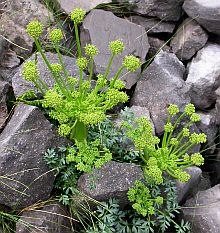 Xatardia scabra
© Teresa Farino
fruiting Fritillaria pyrenaica (Pyrenean Snakeshead). As the usual rain began, we climbed steeply through more pines and Abies alba (European Silver-fir) to the limestone buttress of the Cadí ridge itself. Our fourth wintergreen, Pyrola chlorantha (Pale-green) was frequent in the wood, along with Gymnocarpium robertianum (Limestone Fern), Salix pyrenaica (Pyrenean Willow), Dryas octopetala (Mountain Avens) and Crepis pygmaea (Pygmy Hawk's-beard). A final push to the scree at the base of the ridge yielded Daphne cneorum (Garland Flower) and Xatardia scabra, a curious umbellifer which is endemic to the Pyrenees, with gems at the highest point including Ranunculus parnassiifolius (Parnassus-leaved Buttercup), the Pyrenean endemic columbine Aquilegia pyrenaica ssp. pyrenaica, Reseda glauca (Pyrenean Mignonette) and Saxifraga aizoides (Yellow Mountain Saxifrage).
Xatardia scabra
© Teresa Farino
fruiting Fritillaria pyrenaica (Pyrenean Snakeshead). As the usual rain began, we climbed steeply through more pines and Abies alba (European Silver-fir) to the limestone buttress of the Cadí ridge itself. Our fourth wintergreen, Pyrola chlorantha (Pale-green) was frequent in the wood, along with Gymnocarpium robertianum (Limestone Fern), Salix pyrenaica (Pyrenean Willow), Dryas octopetala (Mountain Avens) and Crepis pygmaea (Pygmy Hawk's-beard). A final push to the scree at the base of the ridge yielded Daphne cneorum (Garland Flower) and Xatardia scabra, a curious umbellifer which is endemic to the Pyrenees, with gems at the highest point including Ranunculus parnassiifolius (Parnassus-leaved Buttercup), the Pyrenean endemic columbine Aquilegia pyrenaica ssp. pyrenaica, Reseda glauca (Pyrenean Mignonette) and Saxifraga aizoides (Yellow Mountain Saxifrage).
The long walk down ended at the bar in Estana, where we collapsed along with the more energetic of the dogs (by now virtually comatose). As we enjoyed a well-earned beer, we spotted a lone Lammergeier cruising along the distant ridge.
24 June - Tossa d'Alp and Meranges
We spent the morning of our last day on the 2,536-metre summit of Tossa d'Alp, high above La Molina. The telecabina service had restarted for the summer season that very morning, and we ascended silently over hundreds of spikes of Gentiana lutea, with Alpine Choughs circling overhead, to the cooler air of the high dry limestone, where we were immediately confronted by the superbly photogenic purple of the ten-lobed Gentiana pyrenaica, with Erigeron uniflorus (One-flowered Fleabane) and Carduus carlinoides (Pyrenean Thistle) growing nearby.
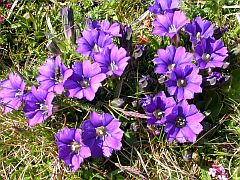 Pyrenean Gentian
Pyrenean Gentian
Gentiana pyrenaica
© Teresa Farino
As we climbed higher we found Androsace villosa, Daphne cneorum, Linaria alpina (Alpine Toadflax) and Lotus
corniculatus ssp. alpinus (Alpine Birdsfoot-trefoil). Amongst the scree and limestone rocks were Veronica
aphylla (Leafless-stemmed Speedwell), the diminutive Iberis spathulata (Spoon-leaved Candytuft), with its
beautiful seeds, Petrocallis pyrenaica (Pyrenean Whitlow-grass), Potentilla nivalis ssp. nivalis and
Astragalus australis (Southern Milk-vetch), with its inflated, shiny pods. While the clouds built up, we scrambled
over rocks near the summit, finding Pritzelago alpina ssp. alpina (Chamois Cress) Erysimum seipkae,
Potentilla alchimilloides (Alchemilla-leaved Cinquefoil), Artemisia umbelliformis (Yellow Genipi)
and Kobresia myosuroides. As we returned to the telecabina, we passed
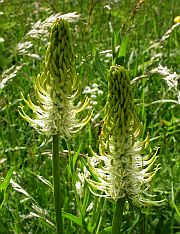 Spiked Rampion
Spiked Rampion
Phyteuma spicatum
© Teresa Farino
Medicago suffruticosa ssp. suffruticosa (Sprawling Medick) and Trifolium thalii.
After another delicious lunch in the pinewoods we drove to the siliceous rocks near Meranges for a complete contrast of lush meadows filled with colourful plants such as Phyteuma spicatum (Spiked Rampion) and Gentiana lutea and teeming with butterflies. Amongst the Polygonum alpinum (Alpine Knotweed) lining the banks we saw Astrantia Major (Astrantia), the beautiful Paradisea liliastrum (St Bruno's Lily) and the umbellifers Laserpitium latifolium (Broad-leaved Sermountain), Carum carvi (Caraway) and Endressia pyrenaica (Endressia). Beside the stream we also encountered the striking Saxifraga aquatica (Water Saxifrage), with Scrophularia alpestris and Carduus carlinifolius (Carline-leaved Thistle) to finish.
We had our last snack in a sensational setting accompanied by an accordion and flute player. Immense thanks to Teresa for her organisation and competence, for giving us a comprehensive and extremely full six days of botanising, and for showing us other fascinating aspects of the wildlife of the eastern Pyrenees.
This report was written by Brian Attock, Kenneth Carlisle, John Edgington, Rita Hemsley, Libby Houston, Graeme Kay and Mark and Clare Kitchen,
and was edited by Teresa Farino. It was previously published in BSBI News 100 ; 64-66 (September 2005).
Botanical holidays in Spain and Portugal:
Wildlife of the Catalan Pyrenees
A Feast of Flowers - botanical holidays in the Picos de Europa
Reports of other botanical trips in Spain and Portugal:
IWT Feast of Flowers in the Picos de Europa - Trip report 2009
BSBI Botanical Tour in the Castilian Páramos - Trip Report 2009
BSBI Botanical Tour in the Valle de Benasque - Trip Report 2008
BSBI Botanical Tour in the Sierra de Grazalema - Trip Report 2007
BSBI Botanical Tour in Western Portugal - Trip Report 2006
BSBI Botanical Tour of the Picos de Europa - Trip Report 2004
Related information:
Read about Teresa Farino
Botany holidays in Spain & Portugal
|